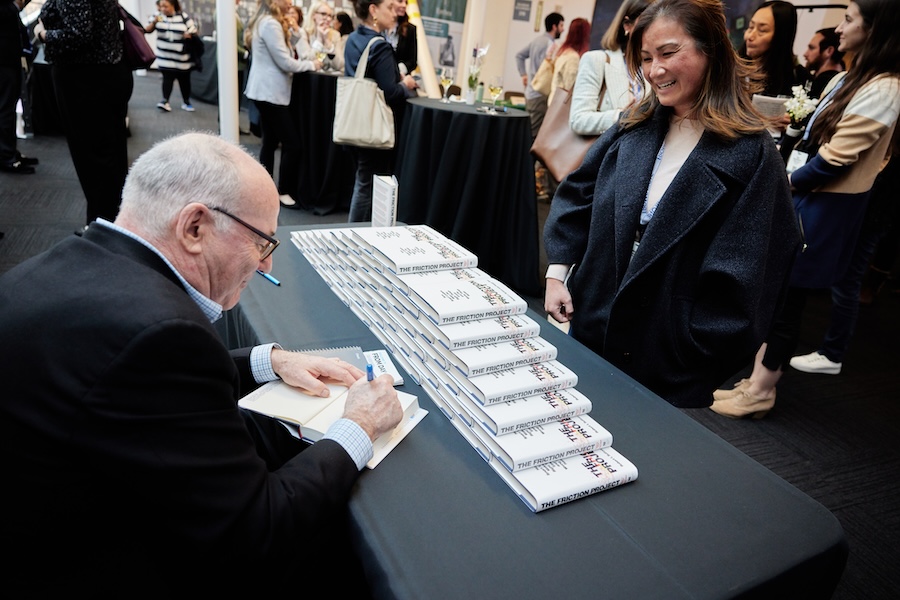Major corporations like Google, Facebook, and Salesforce have made headlines for their exceptional commitment to rapid growth. But as Robert I. Sutton, PhD, author and professor of management science and engineering at Stanford University points out: “They all got real big, and now it’s real hard to get things done in all three of them.” Scaling is not always the answer, a point Sutton elaborated on in a fireside chat at From Day One’s Silicon Valley conference.
Drawing from seven years of hands-on research, Sutton, who is also the bestselling co-author of the new book The Friction Project: How Smart Leaders Make the Right Things Easier and the Wrong Things Harder, teaches leaders how to become “friction fixers” in their organizations. Among the keys: civility, caring, and love for propelling designs and repairs.
Good Friction vs. Bad Friction
At executive education classes at Stanford, Sutton asks students what is driving them crazy about their companies. Some of their usual expressions of frustration aren’t fit to print. All responses indicated “bad friction,” or small unnecessary roadblocks that make it impossible to do your job.
But Sutton says there is “good friction” as well. As an example, he describes two different Stanford students who developed innovative healthcare products. One is the notorious Elizabeth Holmes, whose scam blood testing product was quite fortunately blocked by the FDA, though she managed to work around the system through personal outreach. The other is Greta Meyer and Amanda Calabrese, who went through the proper tests to get their Sequel brand of tampons FDA-approved.
Having proper systems in place provides good friction that can slow down ideas that are ill-conceived or out of control. “The analogy we use is a race car. You don’t go pedal to the metal the whole time. You slow down on the curves. You come in for a pitstop,” Sutton said. “There’s a lot of evidence that the best leaders know when to stop and when to go.”
This doesn’t just apply to science-based organizations. “Creativity is a fundamentally inefficient process. It's about failure. It's about conflict. It's about dead ends. It's about frustration. And that's if you're doing it right,” Sutton said. Guidelines and systems in creative organizations can establish a pathway for success. At Pixar Studios, Sutton says executives have told him, “We do it over and over and over again until it is good enough for us.” Having a more measured process is key. “The Marvel Comic Universe seems to be a great example of going too fast,” moderator Steve Koepp, chief content officer at From Day One added. “The last few pictures have not been so great.”
Power Poisoning
It’s often the leadership team that can cause the bad friction at organizations. “There's a lot of evidence that power does bad things to our minds as human beings,” Sutton said, referring to this as “power poisoning.” Powerful people have “an absence of inconvenience” because “they don’t have to do the things that the little people do.” That includes not being familiar with the products or services that can make or break an organization.
“When people get in positions of power, they focus more on their own needs, they focus less on the needs of others, and they act like the rules don't apply to them,” Sutton said. Preventing the growth of oblivious leadership can help a company stay welcoming, nimble, and effective.

Those in positions of power can also become overly tempted to scale. Sutton points out that leaders tend to add more people to their team when they are behind in work. But when you add more people to a late project, it just gets later. “You have to onboard them, and then you have more people to coordinate,” Sutton said.
Sutton says there are few obvious moments when an organization should slow down. One is when a decision being made is irreversible, like selling the company. The other is when things are going well. If you have already found an efficient way to do something, rushing to do it faster might make it less effective.
Friction should also be applied to business relationships. Some of the most effective partnerships are “deep, caring, efficient” teams developed over time. “The evidence is that the best teams, whether they’re starting companies, developing products, or putting on Broadway plays, work together a lot and develop prior joint experience,” Sutton said. “That’s why so many great Silicon Valley companies were founded by people who worked together when they were students.” By slowing down, creating structure, and developing more meaningful relationships over time, organizations can foster creativity and encourage efficiency.
Katie Chambers is a freelance writer and award-winning communications executive with a lifelong commitment to supporting artists and advocating for inclusion. Her work has been seen in HuffPost, Honeysuckle Magazine, and several printed essay collections, among others, and she has appeared on Cheddar News, iWomanTV, and CBS New York.
The From Day One Newsletter is a monthly roundup of articles, features, and editorials on innovative ways for companies to forge stronger relationships with their employees, customers, and communities.